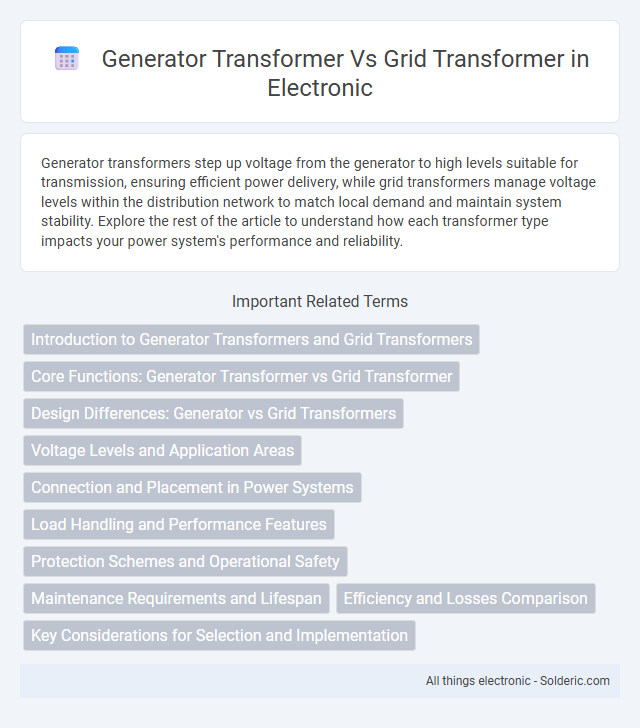Generator transformers step up voltage from the generator to high levels suitable for transmission, ensuring efficient power delivery, while grid transformers manage voltage levels within the distribution network to match local demand and maintain system stability. Explore the rest of the article to understand how each transformer type impacts your power system's performance and reliability.
Comparison Table
| Feature | Generator Transformer | Grid Transformer |
|---|---|---|
| Primary Function | Steps up generator voltage for transmission | Steps down transmission voltage for distribution |
| Location | Located near power generators | Located within distribution substations |
| Voltage Levels | Typically from ~13.8 kV to 230-500 kV | Typically from 230-500 kV down to 11-33 kV |
| Rated Power | High MVA rating aligned with generator output | Variable, depending on distribution demand |
| Design Considerations | Handles fluctuating generator load and starts | Optimized for stable grid voltage and load profiles |
| Cooling Method | Oil or air-cooled, designed for continuous operation | Oil, air, or forced cooling as per load |
| Impedance | Lower impedance for generator stability | Higher impedance to limit fault currents |
| Typical Applications | Power plants, generation stations | Substations, distribution networks |
Introduction to Generator Transformers and Grid Transformers
Generator transformers connect power generators to the electrical grid, stepping up voltage to ensure efficient energy transmission. Grid transformers serve as critical links within the power distribution network, adjusting voltage levels between high-voltage transmission lines and lower-voltage distribution systems. Understanding the distinct roles of generator vs grid transformers helps optimize your power system's reliability and performance.
Core Functions: Generator Transformer vs Grid Transformer
Generator transformers step up voltage from generators to match the grid's higher transmission voltage, ensuring efficient power transfer with minimal losses. Grid transformers, installed within substations or distribution networks, manage voltage regulation, load balancing, and system stability across varying grid demands. Both types incorporate specialized insulation and cooling systems tailored to handle different load profiles and operational stresses unique to generation or distribution environments.
Design Differences: Generator vs Grid Transformers
Generator transformers are specifically designed to handle the variable voltage and frequency output directly from generators, featuring robust insulation systems and cooling mechanisms to manage high short-circuit currents. Grid transformers, by contrast, are optimized for steady-state operation, focusing on voltage transformation and system stability within the electrical grid, with designs prioritizing efficiency and minimal losses. The core windings, insulation classes, and cooling techniques differ significantly to accommodate the distinct electrical stresses and operational roles of each transformer type.
Voltage Levels and Application Areas
Generator transformers typically operate at medium voltage levels ranging from 11 kV to 33 kV, stepping up the voltage for efficient transmission from power plants. Grid transformers, on the other hand, handle higher voltage levels, often between 110 kV and 765 kV, to facilitate long-distance power distribution across transmission networks. Your choice between these transformers should consider the required voltage transformation and the specific role within power generation or grid infrastructure.
Connection and Placement in Power Systems
Generator transformers are directly connected to the generator terminals and typically placed as close to the generator as possible to step up voltage for efficient transmission. Grid transformers, positioned within substations or distribution networks, connect the transmission system to distribution lines and regulate voltage levels between different parts of the grid. Your understanding of these placements is crucial for optimizing power flow and system stability.
Load Handling and Performance Features
Generator transformers are designed to handle fluctuating and high short-circuit currents from the generator, ensuring stable voltage regulation and protecting the generator during transient conditions. Grid transformers manage load variations from the utility grid with robust thermal performance and efficient voltage step-up or step-down capabilities to maintain stable power delivery. Your choice depends on the specific load handling and performance requirements of your power generation or distribution system.
Protection Schemes and Operational Safety
Generator transformers feature specialized protection schemes such as differential protection, Buchholz relays, and overcurrent relays designed to detect faults between the generator and transformer windings, ensuring rapid fault isolation. Grid transformers utilize tap-changer protection, overcurrent relays, and temperature monitoring to maintain system stability and prevent overload or thermal damage. Operational safety in generator transformers is prioritized by isolating generator faults to protect the prime mover, while grid transformer protection emphasizes maintaining power system reliability and preventing cascading outages.
Maintenance Requirements and Lifespan
Generator transformers require more frequent maintenance due to their exposure to high fault currents and fluctuating loads, which accelerate wear on insulation and cooling systems. Grid transformers generally have longer lifespans, often exceeding 30 to 40 years, because they operate under more stable conditions and steady load profiles. Your maintenance schedule should account for the more rigorous inspections and early component replacements necessary for generator transformers to ensure optimal reliability.
Efficiency and Losses Comparison
Generator transformers typically achieve higher efficiency levels, around 98-99%, due to their design optimized for specific load conditions directly tied to the generator output. Grid transformers, handling more variable and distributed loads, often experience slightly higher losses, including increased core and stray losses, resulting in efficiency ranging from 97-98%. Copper losses in generator transformers are minimized by their application in steady state conditions, whereas grid transformers face fluctuating loads causing variable losses and slightly reduced overall efficiency.
Key Considerations for Selection and Implementation
Generator transformers must be selected based on voltage regulation, short-circuit withstand capacity, and fault current characteristics to ensure reliable connection between the generator and the power system. Grid transformers require careful evaluation of load capacity, insulation levels, and cooling methods to handle varying demand and maintain grid stability. Both transformer types involve considerations of impedance, thermal performance, and protection coordination to optimize efficiency and system security.
generator transformer vs grid transformer Infographic

 solderic.com
solderic.com